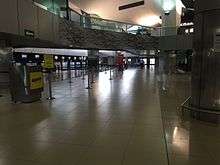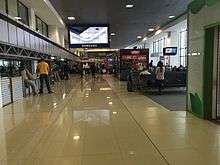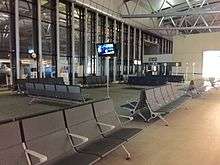La Aurora International Airport
| La Aurora International Airport Aeropuerto Internacional La Aurora | |||||||||||
|---|---|---|---|---|---|---|---|---|---|---|---|
 | |||||||||||
| IATA: GUA – ICAO: MGGT | |||||||||||
| Summary | |||||||||||
| Airport type | Military/Public | ||||||||||
| Owner | Ministerio de Comunicaciones, Infraestructura y Vivienda | ||||||||||
| Operator | Dirección General de Aeronáutica Civil | ||||||||||
| Serves | Guatemala City | ||||||||||
| Location | Guatemala City, Guatemala | ||||||||||
| Elevation AMSL | 1,509 m / 4,951 ft | ||||||||||
| Coordinates | 14°34′54″N 090°31′36″W / 14.58167°N 90.52667°WCoordinates: 14°34′54″N 090°31′36″W / 14.58167°N 90.52667°W | ||||||||||
| Map | |||||||||||
 MGGT Location in Guatemala | |||||||||||
| Runways | |||||||||||
| |||||||||||
| Statistics (2014) | |||||||||||
| |||||||||||
La Aurora International Airport (Spanish: Aeropuerto Internacional La Aurora) (IATA: GUA, ICAO: MGGT) serves Guatemala City, Guatemala. It is located 6.4 km (4.0 mi)[1] south of Guatemala City's center and 25 km (16 mi) from Antigua Guatemala. It is administered by the Dirección General de Aeronáutica Civil.
La Aurora International Airport is the primary airport of Guatemala. The airport went through a massive modernization and expansion. The airport is now able to accept a greater number of flights and larger aircraft. It provides high standard installations to the traveler. The old terminal has been renovated in accordance with its original design. It was partly demolished and was expanded with a new glass-designed concourse and is now able to accommodate up to twenty-two aircraft. The greater project was completed by December 2008. The airport currently has two terminals: Central and North.
La Aurora International Airport is the fourth busiest airport in Central America in terms of passenger traffic, surpassed only by Tocumen International Airport in Panamá, Juan Santamaría International Airport in Costa Rica, and Comalapa International Airport in El Salvador. In June 2007 the airport was certified as Category I; currently (2015), it is considered as Category 3 due to poor management of the installations and government issues, certified by the FAA.[2]
Overview
La Aurora is being renovated, along with other airports in Guatemala, such as Mundo Maya International Airport, Quetzaltenango Airport, Puerto Barrios Airport, and San José Airport.
In July 2007, seven new gates were opened. These gates are equipped with jetway bridges and modern conveniences, also a new parking garage was also built and it can handle up to 500 vehicles.
There are brand new ticket counters. 2007 brought significant gate expansion (11 new gates were available starting December 2007). The airport now has two concourses. The northern concourse has 12 traditional gates and 3 remote gates. The central concourse, is used for larger aircraft as it provides 4–6 gates depending on the size of the aircraft.
The airport's runway currently measures 2,987 m × 60 m (9,800 ft × 197 ft).[1] There have been efforts in the past to expand the runway but this has not yet been possible since there's a commercial area to the north of the runway and a small ravine near the southern side of the runway. Still, the renovation of the runway is in progress. The first phase consists in repaving the runway as well modernizing the illumination system. Future plans to expand the taxiway repave and move all the cargo facilities to San José Airport in Escuintla and Puerto Barrios Airport in Izabal. This will make room for more passenger terminal area and improved taxiways. Finally, the airport administration building is being refurbished and a regional terminal is being built.
La Aurora International Airport has 2 Exclusive VIP Lounges. Los Añejos Business Lounge serving Iberia's first class passengers[3] and Copa Club, a VIP Lounge for passengers travelling on Copa Airlines and United Airlines[4]
Cargo operations are handled beside the passenger terminal building by COMBEX-IM or in the DHL hangars. [5]
The head office of the Dirección General de Aeronáutica Civil is located in the airport Zone 13.[6][7]
History of La Aurora
World War II

During World War II, the airport was used by the United States Army Air Forces Sixth Air Force defending the Central American coastline against Axis powers submarines. The first American personnel began arriving in December 1941; the airfield was improved and expanded by the United States' 805th Engineer Aviation Battalion in early 1942. During its period of American use, the military facilities of the airport were known as Guatemala City Air Base. Flying units assigned to the airport were:
- 51st Fighter Squadron (Detachment) (32d Fighter Group), 2 January 1942 – 9 March 1943, (P-40 Warhawk)
- 74th Bombardment Squadron (40th, 6th Bombardment Groups), 9 January 1942 – 7 April 1944 (B-18 Bolo, B-17 Flying Fortress)
- 44th Bombardment Squadron (40th Bombardment Group) 6 July 1942 – 4 June 1943, (B-18 Bolo)
Detachments from the airfield operated intermittently from San Jose Airport, San José, Costa Rica, and Puerto San José, Guatemala from 1942 though 1944. After the war ended, a small number of Americans remained at the airport performing training duties with the Guatemalan Air Force and also operating a weather station (MATS 6th Weather Squadron). United States personnel were restricted to base during the Guatemalan revolution following the death of Colonel Francisco Xavier Arana on 18 July 1949. Some artillery shells landed on the base during the violence. The facility was closed on 28 July 1949 and turned over to Guatemalan authorities.
Airlines and destinations
Passenger



^1 Iberia flight from Guatemala City to Madrid makes a stop in San Salvador, but the airline does not have traffic rights to transport passengers solely between Guatemala City and San Salvador.
Cargo
| Airlines | Destinations |
|---|---|
| Aereo Ruta Maya | Copán, Palenque, Quirigua, Roatan, Flores |
| Amerijet International | Miami |
| Avianca Cargo | Bogota |
| DHL Aviation operated by ABX Air | Guadalajara, Huatulco, Miami, San Jose (CR) |
| DHL Aviation operated by DHL Aero Expreso | Miami, Panama City–Tocumen |
| DHL Aviation operated by DHL De Guatemala | Mexico City, Miami, Panama City–Tocumen, San José (CR), San Pedro Sula, San Salvador, Tegucigalpa |
| FedEx Express | Memphis |
| Florida West International Airways | Miami |
| LATAM Cargo Chile | Miami |
| LATAM Cargo Mexico | Mexico City |
| UPS Airlines | Atlanta, Miami |
| KLM Cargo | Amsterdam |
| Cargolux | Luxembourg |
Traffic statistics
| Rank | City | Passengers | Top carriers |
|---|---|---|---|
| 1 | Miami, USA | 233,840 | American Airlines, Avianca |
| 2 | Houston, USA | 198,480 | United Airlines |
| 3 | Panama City, Panama | 183,060 | Copa Airlines |
| 4 | Los Angeles, USA | 175,600 | Delta Air Lines, Avianca |
| 5 | Mexico City, Mexico | 164,420 | Interjet, Aeromexico |
| 6 | San Jose, Costa Rica | 160,260 | Copa Airlines Colombia, Copa Airlines, Avianca Costa Rica |
| 7 | San Salvador, El Salvador | 159,220 | Avianca, Veca |
| 8 | Madrid, Spain | 108,180 | Iberia |
| 9 | Atlanta, USA | 102,800 | Delta Air Lines |
| 10 | Managua, Nicaragua | 99,160 | Copa Airlines, Avianca |
| 11 | Flores, Peten | 81,960 | Avianca, TAG |
| 12 | Dallas, USA | 80,980 | American Airlines |
| 13 | Chicago, USA | 76,905 | Avianca |
| 14 | Cancun, Mexico | 61,756 | Volaris |
| 15 | Tegucigalpa, Honduras | 55,480 | Avianca |
Accidents and incidents
- On 1 March 1980, a Douglas C-47 of the Fuerza Aérea Guatemalteca was damaged beyond repair near La Aurora.[8]
- On 6 April 1993, TACA Airlines Boeing 767 ran off the end of runway 19 after landing. A passenger on board filmed the landing which showed the plane coming in too steep, too fast and on a runway with standing water from a tropical storm which had just passed over. A great amount of runway had passed under the plane before touchdown and the pilot forced the landing. In spite of thrust reversers used, the plane could not slow down in time, began to shudder from excessive wheel-braking, overshot the runway and crashed into some structures. Surprisingly, there were no fatalities and the only injured people were 3 non-passengers. The aircraft was written off[9] Retrieved on October 4, 2016
- On April 28, 1995, Millon Air Flight 705 (a DC-8, Registration N43UA) from Miami landed on runway 19 in light rain. The aircraft overran the runway, collided with the approach lights and a perimeter fence, went down a steep slope and ended up in a residential area. The aircraft had touched down at 135 knots with 5300 feet of runway length remaining.
References
![]() This article incorporates public domain material from the Air Force Historical Research Agency website http://www.afhra.af.mil/.
This article incorporates public domain material from the Air Force Historical Research Agency website http://www.afhra.af.mil/.
- 1 2 3 MGGT – LA AURORA Internacional
- ↑
- ↑ http://grupo.iberia.com/portal/site/grupoiberia/menuitem.abd8f742ddc74535bd52b210721061ca/;jsessionid=L2Jja1Mt2AUE3quLfFBRzpPZRXBl1hvOAxWDuZA9fWJB1xMAuaIr!-3744398
- ↑ http://www.copaair.com/sites/cc/es/nuestros-productos/pages/presidents-club.aspx
- ↑
- ↑ "ADDRESSES OF ACCIDENT INVESTIGATION AUTHORITIES As of March 2010." Air Accident Investigation Bureau. Retrieved on 22 January 2012. "GUATEMALA Dirección General de Aeronáutica Civil Aeropuerto Internacional "La Aurora" Zona 13 Guatemala, Centro América"
- ↑ "A 01/11 31 ENE." Dirección General de Aeronáutica Civil. Retrieved on 22 January 2012. "Aeropuerto Internacional La Aurora 9 Av. 14–75 Zona 13 C.P. 1013"
- ↑ "Accident description". Aviation Safety Network. Retrieved 24 July 2010.
- ↑ Aviation Safety Network, Boeing 767 Crash at MGGT.
External links
- Dirección General de Aeronáutica Civil (Spanish)
.jpg)